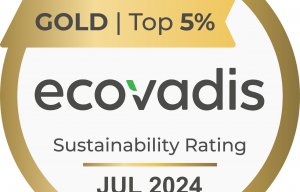
Gold for Archroma
With its portfolio of eco-friendly solutions, the company aims to further continue supporting the sustainable textile supply chain.

4th October 2016
Knitting Industry
|
Reinach
“Archroma is already a leader in driving sustainability in the value chain,” said Wessels. “We intend to build on that position, making use of innovations we have developed and continue to develop for implementation use across our markets.”
Archroma supplies the textile supply chain with chemicals for pre-treatment, dyeing, printing and finishing of textiles. It serves the paper market with its expertise in the management of whiteness, coloration, special coatings and strength for all kind of papers. Archroma also supplies emulsions products used in paints, adhesives, construction, as well as in the textile, leather and paper industries.
Archroma started life in 2013 when private investment firm SK Capital Partners acquired Clariant’s textile, paper and emulsions businesses. In 2014, Archroma acquired 49% of M. Dohmen, an international group specializing in the production of textile dyes and chemicals for the automotive, carpet and apparel sectors, and in July 2015 it added the global textile chemicals business of BASF. Archroma now has 25 production facilities: 11 in Americas, eight in the EMEA region, and six in Asia.
“Archroma is now on a strong top and bottom line growth curve, and we have been rapidly expanding innovation expenditure since we carved out the business from its previous owner,” said Wessels.
One of the examples of the company’s efforts to improve sustainability in the textiles industry is its work in dyeing systems for denim under the brand Advanced Denim. Patagonia, a leading outdoor apparel and clothing brand, was the first last year to announce a new dyeing and manufacturing process developed using Archroma’s Advanced Denim technology.
Advanced Denim uses dyestuffs that are said to bond more easily to cotton, minimizing the resource usage of traditional dyeing of denim. As a result, Patagonia is using 84% less water, 30% less energy and emitting 25% less CO2 than conventional synthetic indigo denim dyeing processes.
In 2014, the company launched a new range of biosynthetic dyes for cotton and cellulose-based fabrics named EarthColors and designed to provide rich red, brown and green colours to denim and casualwear.
In this patent-pending process, Archroma makes use of almond shells, saw palmetto, rosemary leaves, and other natural non-edible agricultural waste products that would otherwise be sent to landfill.
In March 2015, Archroma introduced a new Smartrepel Hydro water repellency agent for outdoor clothing in cotton and synthetic fibres, based on non-fluorine chemistry. With the new range, the company aims to support the increasing adoption of eco-advanced materials and production processes by textile producers and brand owners adhering to industry initiatives, such as the Joint Roadmap towards Zero Discharge of Hazardous Chemicals (ZDHC), and eco-label standards such as bluesign and Oeko-Tex.
This spring, the company also introduced eco-advanced solutions in its range of optical brightening agents (OBAs) for printing and writing papers. Both innovations, marketed under the names Leucophor ACS and Advanced Whitening, aim to offer solutions that require reduced dosage for papermakers, thereby lowering their transport costs and carbon footprint.

Business intelligence for the fibre, textiles and apparel industries: technologies, innovations, markets, investments, trade policy, sourcing, strategy...
Find out more